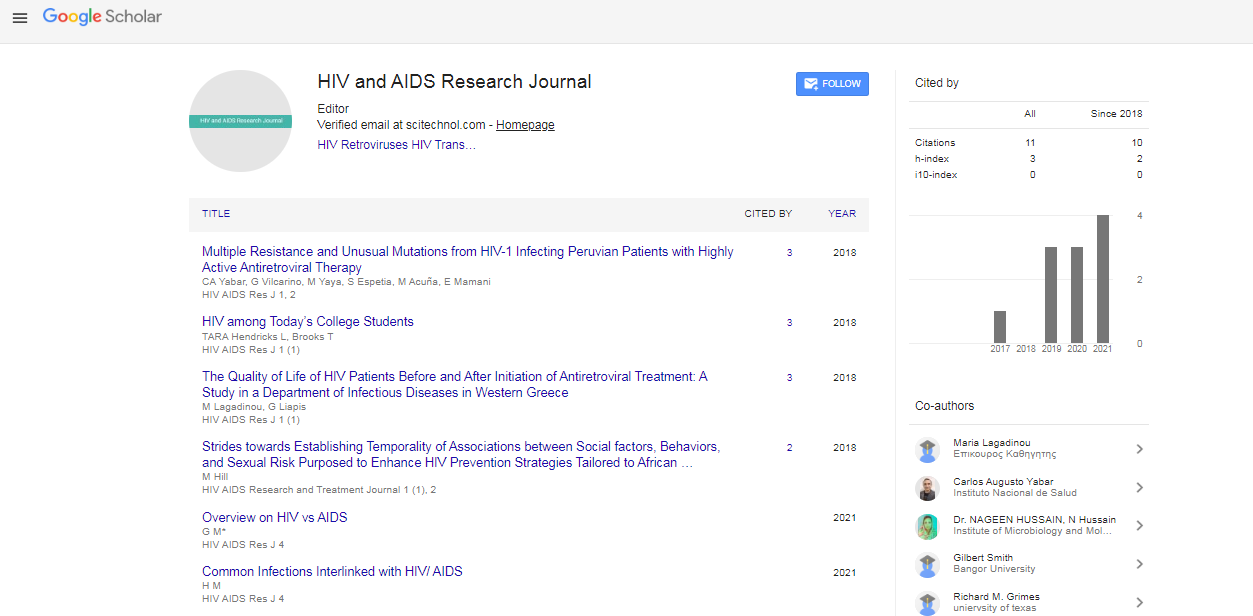Commentary, Hiv Aids Res J Vol: 4 Issue: 3
A brief note on HIV/AIDS
Matjaz Ocepek*
Institute of Microbiology and Parasitology, Slovenia
*Corresponding Author: Matjaz Ocepek Department of Medicine, Institute of Microbiology and Parasitology, Slovenia, E-Mail: Matjaaazocepek@med.pr.sl
Received: 02 November, 2021; Accepted: 16 November, 2021; Published: 23 November, 2021
Keywords: HIV immunodeficiency virus
Introduction
HIV (human immunodeficiency virus) is a virus that infects the body's immune system. HIV can result to AIDS when it is not treated (acquired immunodeficiency syndrome) There is no effective therapy available at the moment. People who contract HIV are infected for life. HIV, on either side, it can be controlled with proper medical care. HIV patients who receive effective HIV treatment can live long, good health lives and protect their partners.
History
HIV infection in humans was caused by microscopic of chimpanzee in Central Africa. The chimpanzee form of the virus (known as simian immunodeficiency virus, or SIV) was most likely transferred to humans when humans chased this chimpanzee for food and got in contact with their contaminated blood. As per investigation, HIV may have spread from chimpanzee to humans as early as the late 1800s. HIV gradually spread across Africa and later into other parts of the world over decades. The pathogen has been known to exist in the United States since at least the mid to late 1970s.
Symptoms
Within 2 to 4 weeks of infection, some people develop flu-like signs (called acute HIV infection). These clinical signs could last a few weeks or even several weeks. Among the possible symptoms are: Fever, chills, rash, night sweats, muscle aches, sore throat, fatigue, swollen lymph nodes, and mouth ulcers are all symptoms of the flu.
However, some members may not feel ill during an acute HIV infection. These symptoms do not indicate that individuals have HIV. These symptoms can also be caused by other illnesses.
Stages of HIV
When people with HIV don’t get treatment; they typically progress through three stages. But HIV medicine can slow or prevent progression of the disease. With the advancements in treatment, progression to Stage 3 is less common today than in the early days of HIV. When HIV patients do not undergo care, they generally focus on three stages. However, HIV medication can slow down or stop the disease progression. With advances in treatment, development to Stage 3 is less common now than it was in the early days of HIV.
Stage 1 Acute HIV infection
People who have a high level of HIV infection in their blood. They are highly infectious. Some people are facing flu-like symptoms. This is the body's common reaction to infection. Some people, however, might not even feel sick immediately or at all. If persons have flu-like signs and believe that might be exposed to HIV, seek medical attention and request an initial infection test. Acute infection can be diagnosed using antigen/ antibody tests or nucleic acid tests (NATs).
Stage 2 Chronic infections
This is also referred to as asymptomatic HIV infection or clinical latency. HIV is still alive and well, but still it reproduces at a very low rate. During this stage, people may not have had any symptoms or become ill without HIV medication, this period could last a decade or longer, though some people may progressive condition that affects. During this stage, people can transmit HIV. At the end of this stage, the amount of HIV in the blood (known as viral load) increases while the CD4 cell count decreases. As the virus levels inside the body rise, the person may experience symptoms and progress to Stage 3.People who takes HIV medication as directed may never progress to Stage 3.
Stage 3 Acquired immunodeficiency syndrome (AIDS)
The most dangerous stage of HIV infection. People with These conditions have such weakened immune systems that they are susceptible to an increase in the number of serious diseases known as opportunistic infections. When a person's CD4 cell count falls below 200 cells/mm or if they grow certain opportunistic infections, they are diagnosed with AIDS. People suffering from AIDS may have a high infection rate and be highly infectious without treatment; people with AIDS have a threeyear survival rate.
 Spanish
Spanish  Chinese
Chinese  Russian
Russian  German
German  French
French  Japanese
Japanese  Portuguese
Portuguese  Hindi
Hindi 